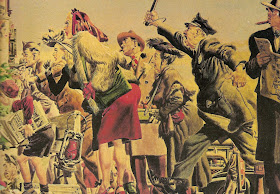In brief, Dorne started life at the bottom, further burdened by ill health. Nevertheless, he was driven to succeed, a task made easier by his ability to draw.
Dorne had the capability to be versatile, and was so at times when that was called for. Still, it seems to me that what he really liked to illustrate were scenes featuring crowds of people or, failing that, a detailed setting. To accomplish this, he made many preliminary studies, the final one being as detailed as the finished illustration but usually lacking color. He was hugely productive in terms of completed assignments, yet found the time and energy to do all this preparatory work. I find it astonishing that he could manage that while being involved with other projects such as the Famous Artists School.
Another characteristic of Dorne's illustration is his tendency to exaggerate body poses and gestures, something in the spirit of Thomas Hart Benton. I will deal with another of his stylistic traits below in the Gallery section.
For a reason I can't define, I'm not generally fond of Dorne's illustrations even though I greatly respect his talent and productivity.
Fight scene
Big crowd here. Note the V composition motif that helps holds the image together.
Bedside scene
Now for some exaggerated poses in the form of craning necks.
Wurlitzer juke box advertisement art
The crowd lurks around the edges here.
Maxwell House Coffee advertisement
Lots of detail plus a crowd of kids in the dining room.
Preliminary drawing, crowd scene
Preliminary drawing
Observe that the gentlemen at the left and right have very short legs. Ideally, a person's crotch is about one half of a person's height, though of course people deviate from this measure. For some reason, Dorne's casts of characters have legs that almost always range from normal (as just defined) to shorter than that. Sometimes, a lot shorter, as seen here.
Paperback book cover art
The shorter corporals (why so many corporals? was that in the book?) have short legs, which is how things tend to be in reality.
Detail from Saturday Evening Post story illustration
Perhaps for reasons of composition, Dorne drew a number of people here with noticeably short legs. Examples include the woman in the red skirt, the policeman, and the soldier towards the left side of the image.








Thanks for an excellent post on Dorne, Don. I don't disagree with your assessment of the quality of Dorne's pictures; I think he is revered for his larger role in the field. Not only did he teach himself to draw and become the highest paid illustrator in America (more than Norman Rockwell) but he was also an astonishing life force in illustration. He single handedly founded the Famous Artists School, headed the Society of Illustrators, wrote the code of conduct for graphic artists and served as the teacher, father figure and networker for many of the top illustrators. When Walt Reed told Dorne he was thinking about writing the classic Illustrator in America, Dorne took the shy Reed by the hand to a publisher where Dorne had contacts and basically ordered them to publish the book. When the young Bernie Fuchs first moved to Westport, Dorne spotted him as a winner and convened a luncheon to introduce Fuchs to Norman Rockwell, the new generation to the old. So when Rockwell rhapsodized about the quality of Dorne's artwork, I can't help but think it was partially because he admired the quality of the man so much.
ReplyDeleteAs for the short legs, I never noticed before. It's interesting, but when Dorne drew children he gave them especially long, spindly legs.